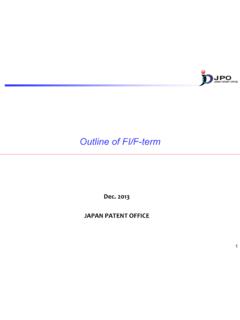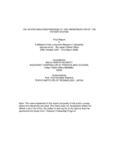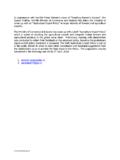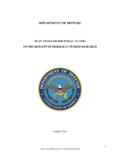Transcription of GUIDE TO LICENSING NEGOTIATIONS INVOLVING …
1 GUIDE TO LICENSING NEGOTIATIONS INVOLVING STANDARD ESSENTIAL PATENTS ( draft ) March 9, 2018 Japan Patent Office i TABLE OF CONTENTS I. Purpose of the GUIDE .. 1 A. SEP Issues and Background .. 1 B. Nature of this GUIDE .. 3 II. LICENSING Negotiation 5 A. Good Faith .. 5 1. Step 1: Offer by Rights Holder of LICENSING Negotiation .. 6 2. Step 2: Expression of Willingness by Implementer to Obtain a License .. 9 3. Step 3: Specific Offer by Rights Holder of FRAND 13 4. Step 4: Specific Counteroffer by Implementer on FRAND Terms .. 14 5. Step 5: Rejection by Right Holders of Counteroffer / Settlement of Disputes in Courts or through ADR .. 16 B. Efficiency .. 19 1. Notification of a Timeframe.
2 19 2. Parties to Negotiation in Supply Chain .. 20 3. Protecting Confidential Information .. 23 4. Choice of Patents Subject to Negotiation .. 24 5. Geographic Scope of LICENSING Agreement .. 25 6. Patent Pool LICENSING .. 26 7. Greater Transparency of SEPs .. 27 III. Royalty Calculation Methods .. 27 A. Reasonable Royalties .. 27 1. Basic Approach .. 27 2. Royalty Base (Calculation Base) .. 29 3. Royalty Rate (Rate) .. 31 a. When Comparable Licenses Exist .. 31 (a) Comparable licenses held by the same patent holder .. 32 (b) Comparable licenses held by third parties .. 32 (c) Patent pools .. 33 b. When comparable licenses do not exist .. 33 4. Other Factors to Consider in Determining Rates .. 34 a. Number of Licensees that Agreed to the Royalty Rate.
3 34 b. Nature or Scope of License .. 35 ii c. Essentiality/Validity/Infringement of Patent .. 35 d. Value of Individual Patents .. 35 e. Negotiating History .. 36 B. Non-discriminatory Royalties .. 36 1. Concept of Non-Discrimination .. 36 2. Royalties for Different Uses .. 37 C. Other .. 38 1. Fixed Rate and Fixed Amount .. 38 2. Lump-Sum Payment and Running Royalty Payments .. 38 1 I. Purpose of the GUIDE A. SEP Issues and Background (Changes in relation to standards and patents) The GUIDE to LICENSING NEGOTIATIONS INVOLVING Standard Essential Patents ( this GUIDE ) aims to enhance transparency and predictability, facilitate NEGOTIATIONS between rights holders and implementers, and help prevent or quickly resolve disputes concerning the LICENSING of standard essential patents ( SEPs ) which are essential in implementing standards in the field of wireless communications and the like.
4 Patents granting monopoly to a technology as a reward for innovative effort and standards designed to spread that technology as widely as possible, in principle, are in conflict with each other, often giving rise to tension between them. That tension has escalated since the 1990 s when the telecommunications technologies started shifting to digital formats, accompanied by a trend toward standardizing the latest technologies while protecting them with patents at the same time. The result has been a growing number of SEP disputes. Standards setting organizations ( SSOs ) have formulated SEP rules ( IPR policy ) designed to prevent disputes, promote the widespread use of the SEPs necessary for implementing technical standards, and ensure the appropriate recovery of investment in research and development related to SEPs.
5 Part of this endeavor has included developing rules to ensure that SEP licenses are fair, reasonable and non-discriminatory ( FRAND ). A considerable body of domestic and international legal precedents has begun to accumulate in relation to SEP disputes, and government agencies around the world are developing guidelines and other initiatives, with certain guiding principles beginning to While there has been concern over the so-called hold-up 1 The Japan Fair Trade Commission revised its Guidelines for the Use of Intellectual Property under the Antimonopoly Act in January 2016 to indicate behavior that could be considered as contravening the Antimonopoly Act in relation to SEPs issued on FRAND LICENSING terms.
6 In November 2017, the European Commission announced the European Commission Communication on Standard Essential Patent (SEP) LICENSING (below, European Communications), urging SSOs to increase SEP transparency and indicating general principles in relation to FRAND LICENSING terms for SEPs. 2 where businesses providing key social infrastructure or services using SEPs are faced with a threat of injunction, legal precedents across the world have come to show a converging trend where such injunctions are permitted only in limited situations. A body of legal cases relating to the concept of FRAND royalties has also started to grow. (Paradigm shift in LICENSING NEGOTIATIONS ) The spread of Internet of Things ( IoT ) in recent years has spurred a fourth industrial revolution across the world whereby more and more infrastructure and devices are connected via the Internet, and this trend is transforming LICENSING NEGOTIATIONS for the SEPs required to implement technologies related to wireless communication among devices.
7 Because SEP LICENSING NEGOTIATIONS in the Information and Communication Technology ( ICT ) field traditionally took place chiefly among telecommunications companies, issues were commonly resolved through cross- LICENSING . Also, the established practice was for NEGOTIATIONS to remain ongoing as necessary after the start of a service. In addition, perspectives on license rates were consistent to some extent among the parties because it was easy for them to assess the scope, essentiality, and value of each other s patents. However, there are now cases, particularly in the United States, in which Patent Assertion Entities ( PAEs ) that are not engaged in business operations, but rather generate revenue solely by asserting patents, are also parties to SEP disputes.
8 Moreover, with the spread of IoT, companies from a whole spectrum of different industries have begun using ICT standards, and thus been brought to the negotiating table. For example, in addition to those telecommunications companies holding SEPs, NEGOTIATIONS may now involve end-product manufacturers such as automobile makers as well as service businesses which do not hold SEPs themselves but need to use them. As the parties to LICENSING NEGOTIATIONS change, so do various aspects of those NEGOTIATIONS . As noted above, given the growing frequency of LICENSING NEGOTIATIONS between ICT companies and companies in other industries, it is becoming harder to resolve disputes through cross- LICENSING .
9 In addition, perspectives on essentiality and LICENSING rates are becoming increasingly divergent, resulting in more serious SEP disputes. Shorter product life cycles and the growing number of patents per 3 product in recent years are increasing the need to resolve more complex disputes quickly and efficiently. (Need for creating this GUIDE ) With companies from a broad spectrum of industries now finding themselves involved in SEP LICENSING NEGOTIATIONS , appropriate information needs to be provided to enable businesses not familiar with such NEGOTIATIONS to feel confident taking a seat at the negotiating table. There is also the issue of a hold-out , where an implementer s failure, after receiving an offer for LICENSING NEGOTIATIONS from the rights holder, to engage in NEGOTIATIONS in good faith in anticipation that an injunction will be denied on SEPs.
10 There have been calls to have this issue addressed. Further, there is a strong call for enhancing the transparency of SEPs. There are industry practices to determine royalties in proportion to the number of SEPs held covering a standard. Due to these practices, rights holders might sometimes declare patents as SEPs2 even when such patents are still in the application phase as well as when they are not truly essential to the implementation of a standard. SSOs typically do not check whether the FRAND-declared patents are in fact essential, or whether changes made to technical specifications during the standard creation process have made a patent inessential. In addition, there is no routine third-party review process at the SEP listing stage.
















